|

by
Andy Lloyd
January 2004 - January 2005
from
DarkStar Website
Spanish version

Part 1
January 2004
The secret knowledge of the Dark Star appears to be widespread within
esoteric literature, as I have discovered over the last few years.
It often
takes the form of an anomalous symbol connected with 7 stars, and featured
as a counterpart to the Sun and Moon
(1).
Sometimes, the
Dark Star is
described in words, as a 'true' Sun that is more significant than the
Sun
itself:
For instance, the Persian and, later, Roman cult of
Mithras:
"It thus appears that the
Mithraists somehow believed in the existence of
two suns: one represented by the figure of the sun god, and the other by
Mithras himself as the "unconquered sun".
It is thus of great interest to
note that the Mithraists were not alone in believing in the existence of two
suns, for we find in platonic circles the concept of the existence of two
suns, one being the normal astronomical sun and the other being a so-called
"hypercosmic" sun located beyond the sphere of the fixed stars."
(2)
The fourth book of
Zecharia Sitchin's Earth Chronicles, entitled 'The Lost Realms' (1990), deals with South American and Meso-American evidence for the
existence of the
Anunnaki.
He argues that early
Sumerian myths transferred
to South America with the migration of the Anunnaki themselves, who were
celebrated by later indigenous peoples there as their ancient gods.
Included
in this are symbolic references to the Winged Disc:
"Tribal beliefs... held that at the very beginning there was an
Olden God, creator of All Things, of the Heaven and of the Earth, whose abode was in
the highest heaven, the twelfth heaven:
"And the Toltecs knew that many are the heavens.
They said there are twelve superimposed divisions;
There dwells the true god and his consort.
He is the Celestial God, Lord of Duality;
His consort is lady of Duality, Celestial lady.
This is what it means.
He is king, he is lord, above the twelve heavens.

"This amazingly sounds like a rendering of
Mesopotamian celestial-religious
beliefs, according to which the head of the pantheon was called
Anu ("Lord
of Heaven") and who, with his consort Antu ("Lady of Heaven") resided on the
outermost planet, the twelfth member of our Solar System. The Sumerians
depicted it as a radiating planet whose symbol was the cross.
The symbol was
thereafter adopted by all the peoples of the ancient world and evolved to
the ubiquitous emblem of the Winged Disc. Quetzalcoatl's shield and symbols
depicted on early Mexican monuments are uncannily similar."
(3)
The civilizations of Central and South America do not appear to have been as
ancient as those of Mesopotamia and Egypt, but there is plenty of evidence
to suggest that some cross-pollination of culture occurred, possibly via
such sea-faring nations as the Phoenicians, or even the Sumerians.
As
amazing as it may seem, some artifacts that have been unearthed in Bolivia,
in the vicinity of Lake Titicaca, are inlaid with cuneiform script that
seems to be of Proto-Sumerian extraction
(4).
This has lead some scholars to
seek
a controversial link between the Mesopotamian culture 5000 years ago
and South America.
We may never know for sure whether there is a basis for historical fact
here, partly because of the almost wholesale destruction of the indigenous
cultures by the Conquistadores, and partly because of the potential for
hoaxed archeological finds.
Little has remained to enlighten academics and
archeologists about the early mythological sources, and controversial
archeological finds that run against the grain of orthodox thought tend to
be side-lined or ignored by academics keen to maintain their credibility.
Then there was the purging of
the Church...
The genocide that took part in
those early days of European colonial conquest ran in parallel with a purist
drive to eradicate ancient pagan knowledge. Even if the ancients of South
and Central America knew of Nibiru, how could we find out?
Certainly, many wonderful monuments remain, and archeologists have uncovered
an advanced dating system suggestive of high learning, particularly among
the Mayans.
Researchers like Richard Day have carried out interesting archeo-astronomical studies to determine whether hidden knowledge of
Nibiru
can be found in the layout of the monuments themselves, particularly those
of
Teotihuacan
(5).
The intricate and accurate dating systems, combined with
the Mayan 'Ages', are suggestive of thinking on a Cosmic scale, possibly
incorporating prophecy of catastrophism from the sky.

This
Mayan stella shows a fiery god embracing the Sun.
It has all the
hallmarks of a Winged Disc whose identity is evidently not solar in origin.
What is most telling, perhaps, is the necklace of seven orbs hanging from
the head of the Mayan god.
The combined symbolism is strongly suggestive of
the visible Nibiru interacting with the Sun in some way.
Does this imagery
help to explain the famous Mayan Ages?
3/3/04
The renowned author of Central American myth,
Maurice Cotterell, has
investigated whether these Ages may be connected with great Solar cycles of
about 3750 years
(6).
This brings the phenomenon within reach of the orbit
of the Dark Star: Sitchin approximates to 3600 years for his Nibiru, and I
have suggested the inter-calendrical period of 3760 years for my Dark Star.
All of which is suggestive of an cosmic time-period lying at the heart of
ancient religious thinking. I shall explore this link in more detail in my
forthcoming book 'Binary Companion'.
What is missing is a direct mythological reference to the Dark Star
amongst
the remaining archaeological evidence. Was such direct evidence lost, or did
it never exist in the first place?
Encouraging information has been passed to me by
Lee Covino. He spotted an
interesting drawing of an Incan altar piece that had been destroyed by the
Spaniards in Cusco, Peru.
Cusco was the capital city of the Incan Empire and was heavily looted by the
Conquistadores. After the destruction an attempt was made to understand what
the Incas were worshipping at the 'Coricancha' in Cusco.
It was decided that
the temple was dedicated to the Sun, based upon the accounts of several
Europeans at the time, many who happened to be Dominican friars.
Graham
Hancock quotes Garcilaso de la Vega:
"What we shall call the high altar, although this expression did not exist
among the Indians, was to the east, and the roof, which was very high, was
of wood, covered with straw.
The four walls were hung with plaques of gold,
from top to bottom, and a likeness of the Sun topped the high altar.
This
likeness was made of a gold plaque twice as thick as those that paneled the
walls, and was composed of a round face, prolonged by rays and flames... the
whole thing was so immense that it occupied the entire back wall of the
temple."
(7)
And so
Coricancha became known to Westerners as the Temple of the Sun.
The
implication was that the 'Indians' were simple Sun-worshippers, and the
wholesale looting and destruction of their iconography prevented any
questions being raised.
Awfully convenient. I wonder whether
the Dominicans
had found imagery that they immediately recognized as heretical in their own
cultural environ, and set about purging it utterly...
Coricancha was not just a repository for a vast amount of wealth. It also
acted as an observatory, containing markers that enabled the Inca priests to
predict eclipses, solstices and equinoxes
(8).
There is clearly more to this
temple than Sun-worship.
This is where the paper that Lee found makes for very interesting reading.
In it, the researcher
Jan Sammer, who has worked with
Velikovsky in the
past, argues that the conclusion that Coricancha was a Solar Temple is
mistaken, and should have been completely dismissed over 100 years ago:
"...There was little reason to doubt the reality of an all-important solar
cult in Tawantinsuyu [The Incan Empire]. But a little over a century ago a
series of momentous literary discoveries changed this situation very
materially.
In 1873 Clemens R. Markham, in the course of a survey of some of
the collections of Madrid's Biblioteca Nacional, lighted upon a previously
unknown sixteenth-century manuscript entitled "Relacion de antiguedades
deste reyno de Piru".
Its author, an Aymara Indian named Pachacuti Sallkamaywa, was from a noble family, newly converted to Catholicism.
"Until the publication of Juan Pachacuti's manuscript a century ago we
lacked the evidence that could decisively counter the unanimous opinion of
the various chroniclers that the Temple of Viracocha was dedicated to the
Sun.
However, Pachacuti included in his manuscript a rough drawing of the
altar of that temple. The altar itself had destroyed soon after the
conquest.
This representation is crucial for an understanding of the cult of
the Coricancha and, thus in Tawantinsuyu as a whole."
(9)
See report
HERE.

The
golden disc is shaped in a distinctly oblong shape, and is separate from
the self-evident Sun-disc.
We also have a complex set of celestial symbols
of which the Sun is simply one of several. The elliptical disc appears to be
part of a celestial Trinity.
This is hardly the hall-mark of a major Solar
Cult among the Inca peoples.
So if Coricancha was not dedicated to the Sun, then what did the Incas
devote their golden temple to? In the centre of the diagram of the High
Altar is a massive golden ellipse.
To either side of it are the
Sun and
Moon, and depictions of Venus as the Morning and Evening Star.
The ellipse
is surmounted by a cross of stars, and further stars lie below it. This
celestial scene focuses upon the ellipse as the all-important source of the
Universe in the form of the god Viracocha.
Sammer then goes on to argue that
this ellipse signifies the 'true Sun' of the Inca, a phrase we have heard
before...
"As to the disk itself, Pachacuti describes it thus:
"Dicen que fue imagen
del Hacedor del verdadero sol, del sol llamado Viracochan
pachayachachiy" - "They say that it was the image of the Creator of the true
sun, of the sun called Viracochan pachayachachiy."
Viracochan pachayachachiy
is usually translated as "Viracocha, Ruler of the Entire Earth." ... Viracocha is called the "true sun" ... to distinguish him from our familiar
luminary."
(9)
Does the elliptical disc that was the centre-point of the Inca religion
point to a quite different 'true sun'? Might this heretical religious belief
be the true meaning of the widespread devastation of the indigenous culture
by the Conquistadores?
Let us say that a similar heresy was practiced in Europe at the time by
secret cults already persecuted by the Church.
If the Spaniards then came
across an 'Indian' people in South America who independently lavished their
remarkable wealth on such iconography, would that idea not return to Europe
to reinforce the cross-cultural truth of that heresy?
What better course to
take than to destroy the temple, melt down the gold and declare the ravished
remains a 'solar' cult so that no further questions could be asked.
"Pachacuti does not tell us explicitly what was the "Sun called Viracochan
pachayachachi" only that it was not our Sun, which he designates as Inti.
The solution to this puzzle will obviously provide us with a most important
clue to the real cult of Tawantinsuyu."
(9)
See report
HERE.
Sammer goes on to argue that the symbolism is meant to depict Saturn, but I
think this is unlikely. Is the ellipse and cross of stars a representation
of the Dark Star? Without a more detailed examination of the High Altar it
is difficult for me to say.
We know that Nibiru's orbit is highly
elliptical, and that it is symbolically connected with a celestial cross.
There's every chance that this diagram indicates that the Incas were aware
of the Dark Star and its return to our solar system.
If Sitchin is correct
about the
Anunnaki's love of gold then we have a further connection with the
rich contents of Coricancha, the 'golden enclosure'. It is a fascinating
possibility.
References
1.
A. Lloyd 'Winged Disc' 2001 Available from the author:
http://www.darkstar1.co.uk/dst.html
2.
D. Ulansey 'Mithras and the Hypercosmic Sun'
http://www.well.com/user/davidu/mithras.html
3.
Z. Sitchin 'The Lost Realms' p29, Avon 1990
4.
World-Mysteries.com "Fuente Magna - Rosetta Stone of the Americas"
5.
R. Day 'Nibiru Planet X: Evidence from Antiquity' 1998
6.
M. Cotterell & A. Gilbert 'The Mayan Prophecies' Appendix 4, Element 1995
7.
G. Hancock & Santha Faiia 'Heaven's Mirror: Quest for the Lost
Civilization'
p277, Penguin 1998
8.
http://www.windows.ucar.edu/tour/link=/the_universe/uts/cuzco.html
9.
J. Sammer 'The Cosmology of Tawantinsuyu'
Part 2
August 2004 and January 2005
Other anomalous finds from Peru add fuel
to this celestial fire. Kathy Doore is a researcher who has
travelled to Peru many times in connection with the
Ica Stones, and
runs the website
Labyrinthina.com
(2).
Some time ago
she sent me some images of an example of an Ica Stone that appeared
to show anomalous celestial phenomena that could well be related to
a previous appearance of Nibiru.
If these carved river stones are
authentic in displaying the artwork of an ancient people inhabiting
the lands of Peru, then this is certainly strong evidence.
But I was
cautious initially, because other Ica Stones (and there are
literally tens of thousands of them) show dinosaurs and such like.
It all seemed a little far-fetched.
|
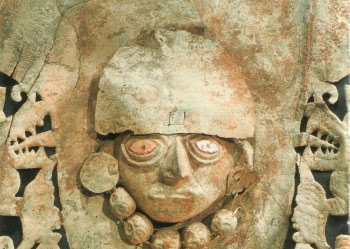 |
This image
shows an Andean silver headdress said to depict a 'warrior flanked by
two dragons'
(5).
Note the 7 discs creating a necklace
around the warrior's neck (the one to the far right is
damaged).
If one takes the dragons to be fiery wings
flanking a central disc (and the warrior's face is
clearly spherical) then we can see the classic Winged
Disc imagery emerge here.
This is Dark Star symbolism, made all the more poignant
by the inclusion of the seven discs; showing the seven
orbiting moons, two of which are major, five minor.
The
two major moon discs correspond to the uraei of the
Egyptian Winged Discs. |
The primary investigator of
the Ica Stones
was the late
Dr Javier
Cabrera.
He set about trying to collect, catalogue and analyze
patterns among the Stones, obtaining them for practically nothing
from Peruvians who claimed that they had excavated them.
Archaeological digs must be permitted officially in Peru, and this
led to certain problems of authenticating the finds when the
Peruvian media became involved:
some of the people who were original
sources of the Ica Stones changed their stories when pressed by the
authorities and claimed to have created the tens of thousands of
stones over the course of several years.
The matter of the Ica Stones
had already been dismissed by academic archaeologists in general,
and now was firmly debunked by the media.
Despite this, there
remains a fascination for them. This is probably because the
accusation of 'fraud' flies in the face of common sense.
There are up to 50,000 of these stones in private collections around
the globe; the process of creating them would have amounted to an
industrial scale output.
Yet they have always been worth next to
nothing individually, and for many years languished in rubbish piles
in the Ica museum.
Furthermore, there was scientific evidence to
suggest that the engravings were indeed old, and certainly not
contemporary, as the frustrated Dr Cabrera explained:
"On January 28, 1969 I received word from
Eric Wolf that the results
of the laboratory analysis conducted by a Professor Frenchen and his
assistants at the University of Bonn were available.
The stones were andesite and were covered by a patina or film of natural oxidation
which also covered the etchings, permitting one to deduce that they
are very old.
"In view of the fact that the patina of oxidation that covered the
stones proved the general but not precise antiquity of the
engravings, and in view of the fact that precision could only be had
by using the comparative methods of stratigraphy and paleontology, I
requested authorization in April 1970 from the Patronato Nacionial
de Arqueologia to carry out excavations in the appropriate zone.
This institution alone had the power to authorize such excavations.
On July 16, 1970, my request was refused. Thus the only means of dating the Engraved Stones of Ica was closed to me."
(2)
In addition, several Ica Stones were discovered in unearthed tombs
in the Ica region by archeologists in the 1960s, self-evidently
authenticating these particular stones and bringing into question
the almost universal dismissal of the Ica Stones in general:
"In 1968, the archeologist Pezzia Assereto, who had accompanied
Agurto Calvo, published a book on the archeology of the province of
Ica, in which he makes note of the discovery:
"Agurto was able after
several attempts to find an engraved stone inside a tomb in the
sector of Toma Luz of the Hacienda Callango del Valle in Ica on 20
August 1966...
After informing the Museo Regional of Ica of such an
important find, Agurto and I made another excavation on 11 September
of the same year, in the hill called Uhle of the sector of La Banda
in the Hacienda Ocucaje, and we found for the first time an engraved
stone inside a tomb of the Paracas culture, a thing I was not
expecting, but which proved, by association, the
authenticity of these artifacts".
(2)
Even so, things are rarely black and white. It is entirely possible
that even if there are original, ancient Ica Stones dug out of the
ground or found in tombs, there may also be a large body of faked
Stones created by some of the locals hoping to cash in on the find.
In which case, how does one determine which of them are genuine and
which are faked, and how does one draw any firm conclusions from the
body of Stones as a whole?
A similar predicament presents itself
when assessing the
Crop Circles prevalent each year in
the English countryside; no one thinks they are all 'genuine', but some
researchers consider it likely that some crop circles are truly
anomalous.
This complex picture seems plausible, so we must tread
carefully when similarly considering the Ica Stones.
|
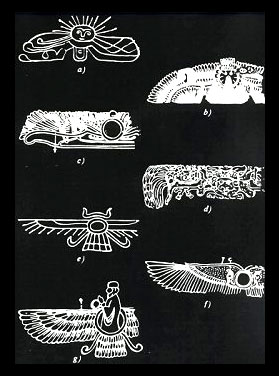 |
Comparing
Winged Discs from around the Globe:
a)
South American
b) Toltec
c) Aztec
d) Mayan
e) Babylonian
f) Egyptian
g) Iranian
From "Atlantis: The Seven Seals" by
Zoltan Andrew Simon (1983).(8) With thanks to
Greg Jenner
|
If entirely genuine,
the Ica Stones present a massive body of
ancient scientific knowledge in the realms of astronomy, medicine,
cartography, biology, and technology and natural history.
So it is
little wonder that the authenticity of these myriad stones has been
called into question.
Dr Cabrera's most explosive claim was that
depictions showing men alongside dinosaurs indicated that the stones
emanated from the very remote past, and that mankind lived during
the era of the dinosaurs. This rather incredulous claim probably
banged a few more nails into the coffin of the Ica Stones; it
certainly would not have endeared his efforts to academia.
Yet others have also suggested such a possibility.
For example, on
the fossilized bed of the Paluxy River in Texas the so-called 'Taylor Trail' of human footprints is crossed over by prints of a
three-toes dinosaur. The ancient rock at this site is dated to over
100 million years
(3).
Fossilized footprints
have been discovered in deep mines, indicating human antiquity well
beyond the current estimates. Conversely, other relics from the
ancient past, like the 5000 year old Egyptian 'Palette of Narmer' seem to show dinosaurs
interacting with people
(3).
This area of research is a fascinating one, though somewhat beyond
the scope of this essay. However, I think one should be careful
about assuming that a body of knowledge of dinosaurs among ancient
peoples might indicate either remote human existence or the
contemporary anomalous existence of such 'live' creatures.
There is
another possibility.

The
supposed existence of a destroyed civilization pre-dating
Egypt and
Sumer falls into two categories:
the fabled existence of
Atlantis,
as described by Plato, and the intervention of space-faring gods, or
'ancient astronauts'.
Both schools of thought have a spectrum of advocates, (and many
detractors), and both theories call for advanced technology and
scientific knowledge among a lost ancient people in both cases.
Traces of that knowledge are thought to have passed down by oral
tradition, anomalous material evidence and through the careful and
detailed construction of ancient monuments.
It seems eminently plausible to me that a working scientific
knowledge of remote Natural History of our Earth would have been
understood by either Atlanteans or, even more likely,
the Anunnaki.
In the case of the latter, the Anunnaki are described as having a
keen interest in mining for gold
(4),
beginning in Africa and
probably extending to South America.
It does not seem beyond the
realm of possibility that dinosaur bones were excavated, studied and
perhaps collected.
Thus, a technologically advanced race of humans
in antiquity may have known of the dinosaurs, and that knowledge may
have filtered down to ancient peoples after the Cataclysm through
dragon-based myths and the like.
Perhaps, then, the Ica Stones were created by ancient Peruvian
peoples based upon an inherited knowledge of the Earth's Natural
History.
We could then rule out the existence of dinosaurs still
roaming the Earth in living memory (which seems unlikely,
although
not entirely impossible) and the idea, promulgated unsuccessfully by
Dr Cabrera, that the Ica Stones stand as a unique testament to the
very remote existence of humanity many millions of years ago.
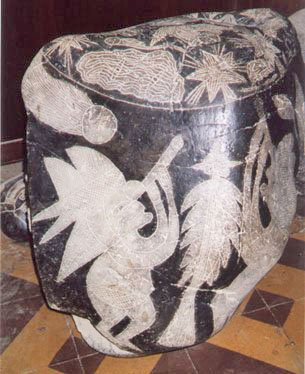
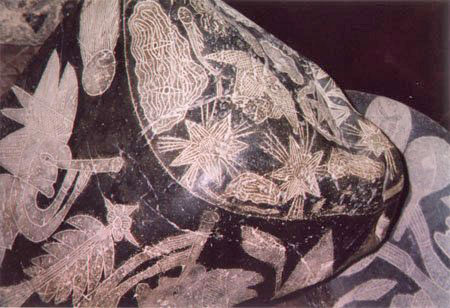
So what of the particular example
highlighted by the researcher Kathy Doore, shown above?
If they are
genuine, ancient Ica Stones created by the indigenous people of Peru
hundreds, possibly thousands of years ago, then do they point to the
existence of the 'True Sun of the Incas'?
This Ica Stone has several
fascinating features. Firstly, the Andeans pictured appear to be
looking up at the heavens using telescopes. One would imagine this
to be utterly impossible for the ancient Incas; a certain mark of
fakery surely?
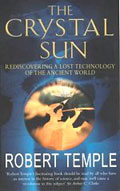 Well,
things are never quite as straightforward as they first appear.
Robert Temple, the author of 'The Sirius Mystery', wrote a book
about the unrecognized collections of ancient lenses in various
museum collections around the world, entitled 'The Crystal Sun'
(6). Well,
things are never quite as straightforward as they first appear.
Robert Temple, the author of 'The Sirius Mystery', wrote a book
about the unrecognized collections of ancient lenses in various
museum collections around the world, entitled 'The Crystal Sun'
(6).
The lenses had been discovered by archeologists for generations and
dutifully handed over to disinterested antiquarians for display in
various museums.
His book makes a strong case for the widespread
use
of lens in the ancient world, and even proposes the use of
telescopes, as can be seen from the shard of Greek pottery that
adorns the front cover of his book (click
image right).
 Temple does not describe examples from South America, but there are
famous examples of worked rock crystal from Meso-America. Temple does not describe examples from South America, but there are
famous examples of worked rock crystal from Meso-America.
I have in
mind, of course, the Mitchell-Hedges Crystal Skulls.
(click image left)
It is not a big leap from these incredible artifacts to working rock
crystal into lenses to be used by the Incas, and thus featuring on
an Ica Stone.
Furthermore, tantalizing evidence for the existence of ancient
lenses in South America is recorded by Harold T. Wilkins in 1945.
Wilkins was born in 1891 in my own home city of Gloucester, and may
even have attended the same grammar school there.
During his
extensive researches in South America before World War II he met Señor Muñoz, a haciendero who owned an estate on the seashore not
far from Guayaquil, Ecuador.
Harold Wilkins relates this remarkable
tale, alluding to the possibility of the finds being linked to a
lost continent in the Pacific Ocean:
"He [Señor Muñoz] set a diver to fish up statuettes from a drowned
and very ancient city lying under water just off shore. The diver
came up with artistic statuettes of men and women whose hair was
dressed in very Egyptian fashion!
They had the same curiously long
slanted eyes as you find in frescoes in the tombs of the Pharoahs.
On their breasts were jewels carved in stone.
The dead and ancient
civilization must have been very, very old; for some of the
statuettes are pornographic – a sign that the makers are of a race
that has lapsed from a higher state of culture.
"As said Muñoz
to me:
'Señor
Wilkins, it may amaze you to hear that
every race in the world is represented in these statuettes, so
incredibly ancient, found under water by my diver.
There are Aryans,
Semites, Caucasians, and even a race remarkably like the modern
Japanese! The race had seals like prisms, covered with hieroglyphs.
Also, I have found ancient convex lenses, under water, there, and
also reflectors.
They were made of obsidian… they must have been
scientific opticians, even astronomers'."
(7)
So perhaps we would do well to keep an open mind on the potential
for ancient optical technology in the Andes.
Of course, this is not
the only remarkable feature of Kathy's Ica Stone. The centre-point
of the heavens pictured on the stone is an odd-shaped feature, not
unlike an upturned boat! Perhaps a celestial barge, like the ones
often featured by the ancient Egyptians? This celestial barge is
accompanied by clouds, meteors and stars.
Additionally, below the
celestial canopy is a huge comet.
But note that the Andeans are not pointing their telescopes at the
great comet, as one might expect. Instead, they are looking at that
celestial barge.
So I wonder whether the 'celestial barge' is the
return of the Dark Star Nibiru, surrounded by its halos and companion 'stars' (really moons). If so, then telescopes are
evidently required to see the heavenly apparition, which is itself
interesting.
A point I shall pursue in
my new book 'Binary
Companion', (which I hope to finish one of these days...)
The lower
and rather prominent 'comet', or sizeable meteor, is perhaps a sign
of danger; the potential for a catastrophe associated with the
return of Nibiru.
Perhaps this is portending the end of an Age when the 'True Sun'
returns?
Of course, this all rather depends upon the authenticity of the
Ica
Stones in the first place, and this is not a question that will be
answered soon, if ever.
Archeologists have no interest in these
stones whatsoever, having assumed from the start that they must be
fake.
But the context of this particular Ica Stone is certainly
consistent with a body of evidence about the Dark Star, the 'True
Sun', that is continuing to build from various sources, both
mythological and scientific.
Update 12/1/05
A Peruvian Binary Circle
Greg Jenner has come across an example of a binary sun circle at
Sillustani in Peru that presumably pre-dates the Incas. The circles
are of unequal size with the largest circumscribed by a platform of
hewn stones.
This larger circle also has a single upright stone
placed within it, as described in an account by E.G. Squier in
'American Naturalist (1870):
"In connection with the group of
chulpas at Sillustani
(click below map), or rather on the same promontory on which
these occur, are found a number of such Sun-circles, which seem
strangely to have escaped the notice of travellers.
The
tradition of their original purpose is preserved in the Quichua
name they still bear of Intihuatana, 'where the sun is tied up'.

"Some of these circles are more
elaborate than others, as shown in the engraving, from which it
will be seen that while the one nearest the spectator is
constructed of simple upright stones, set in the ground; the
second one is surrounded by a platform of stones more or less
hewn and fitted together.
The first circle is about 90' in
diameter; the second about 150' (below
image), and has a single erect stone
standing in the relative position I have already indicated.
A
remarkable feature in the larger circle is a groove cut in the
platform around it, deep enough to receive a ship's cable."
(9)
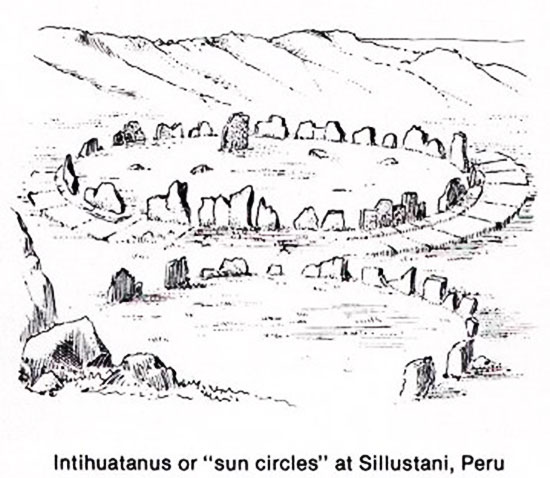
It seems peculiar that there should be 2
suns denoted by these circles.
If this is an example of an early
observatory, like Stonehenge in England or the Medicine Wheels of
North America, then one would expect a single circle, with the
interior standing stone acting as a viewing marker. Two circles
logically imply two suns; a binary star system that was understood
by the ancient Peruvians.
Remarkably, a similar binary solar circle
can be found at Avebury in England
(below image).

I have scant information about these
standing stones, but it seems logical that the single stone within
the larger circle is an archeo-astronomical marker of some kind.
However, a further possibility exists.
In a binary system the centre of gravity of the solar system would
be shifted away from the exact centre of the Sun. Does this stone
provide an approximate location for the centre of the solar system,
thus enabling us to ascertain the approximate whereabouts of a
sub-brown dwarf companion?
Whether or not this is the case, the fact
that such a binary solar circle exists in Peru is further supportive
evidence that the ancient people of this area maintained a tradition
of knowledge that is now, perhaps, lost:
a secret knowledge
of Nibiru...
References
2) K. Doore (Ed);
'Excerpts from "The Message of the Engraved Stones of Ica" by
Javier Cabrera'
www.labyrinthina.com
3) M. Baigent
"Ancient Traces" pp18-20, Penguin 1998
4) Z. Sitchin
"The 12th Planet" Avon 1976
5) A. Cotterell (Ed) "Encyclopedia of World Mythology"
PP294-9 Parragon 1999
6) R. Temple "The Crystal Sun" Century 2000
7) H.T. Wilkins
"Mysteries of Ancient South America"
pp19-20, Rider & Co, London 1945
8) Zoltan Andrew Simon
'Atlantis: The Seven Seals.'
Robinson Expeditions Publishing in Vancouver, B.C. 1983. With
thanks to Greg Jenner
9) "The Primeval Monuments of Peru compared with those in
other parts of the World". Squier, E.G., American Naturalist,
4:1-17, 1870 (obtained by Greg Jenner from William R. Corliss'
book "Ancient Man: A Handbook of Puzzling Artifacts" 1978, p140)
Interesting correspondence:
Andy,
Spanish is my mother tongue so please se paciente conmigo
cuando te escribo en inglés (pls. be patient with me when I
write you in English).
Admirable your work -congratulations. But for it to have the
impact it needs to have I suggest that you modify your East to
West perspective and turn it the other way around as it should
be. Let me explain myself.
Your hypothesis will be highly enriched when you accept what I
call the "West to East Ancient Knowledge Flow "
hypothesis (some
know it as the "Aliaga7 Ancient Knowledge Flow Hypothesis)."
Concretely (besides proposing as early as 1999 that
Nibiru is
actually Aymaru, that Enki is Incay and that
Anu is Allu, and
that in the
Fuente Magna dish the archeologists are wrongly
interpreting POTAKAI because on time it will shown it means
UTA.KI -home on earth), most importantly I am one of the two
more serious proponents in the world of the hypothesis that
ancient knowledge went from South/Central America to the Middle
East more than the other way around.
The other proponent of the same hypothesis is my close friend
and colleague, the brilliant British explorer, Jim Allen (author
of "Atlantis the Andes Solution" and of "The Atlantis Trail").
By practically having demonstrated that Atlantis was
South
America and the its capital of the same name was in the south of
the Bolivian Altiplano, Jim obviously has contributed lots to
support the hypothesis that the flow of knowledge - and
civilization at its dawn - mainly went from the West to the Near
East instead of the other way around as wrongly currently
assumed by most.
I have proposed the same but not from the Atlantis perspective
as Jim has done so. Instead, I proposed this based on the work
of the great Bolivian (from Sorata) Poliglot and Lord Behring
disciple, the late Emeterio Villamil De Rada who was the most
serious Aymarologists (and historians) perhaps of all times.
But the most important proof for this is that in Egyptian
mummies traces of COCA leaves were found.
And this is crucial
because coca is not only native to the East side of the South
American (mainly Bolivia's and Peru's) Andes but also
practically endemic - therefore coca COULD ONLY HAVE FLOWED from
South America (i.e.d, historic Atlantis - or even where the Olympus/Illampus were) to Egypt.
I assure you that as soon as you start using the above mentioned
hypothesis, your "Dark Star Theory" will be accepted, for the
benefit of all of humanity and the biosphere...
Best regards,
Carlos Aliaga Uria
|















